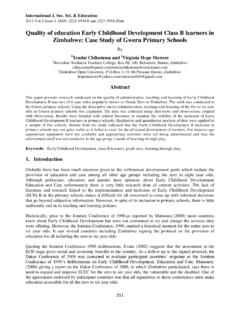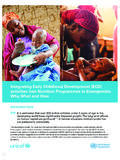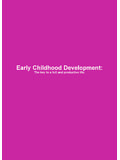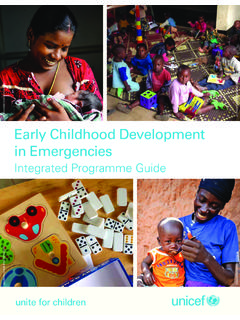Transcription of Methodologies to Evaluate - World Bank
1 Methodologies to Evaluate early childhood development Programs December 2007 Acknowledgement This paper was written by Jere R. Behrman,1 Paul Glewwe,2 and Edward The authors would like to thank Harold Alderman and Markus Goldstein for comments on an earlier draft of this paper. This work was task managed by Markus Goldstein and financed by the Trust Fund for Environmentally and Socially Sustainable development supported by Finland and Norway and by the Bank-Netherlands Partnership Program.
2 1 Department of Economics and Population Studies Center, University of Pennsylvania: 2 Department of Applied Economics, University of Minnesota: Department of Economics, University of California, Berkeley: The opinions reflected in this paper are the opinions of the authors and not opinions of their institutions. TABLE OF CONTENTS 1 A. WHY Evaluate early childhood development (ECD) INTERVENTION PROGRAMS?..1 B. STEPS IN THE PROCESS OF ASSESSING ECD C. THE CREDIBILITY OF AN I. ECD PROGRAM 8 A. TYPES OF Center-based ECD 8 ECD Education for Parents to Enhance Parenting and Child 9 Comprehensive ECD 9 Health Center Programs with Direct ECD 9 B.
3 POLICY MOTIVES AND C. IMPACT Process and Program Implementation 12 Short-Term Program Impact 12 Medium- and Long-Term ECD Program Impact 14 D. VALUING THE IMPACTS TO OBTAIN BENEFITS IN THE SAME METRIC AT THE SAME Valuing the Impacts in a Common 15 Time Program Age, Child Age, Duration of Exposure and Lags in 16 Including All the Major Impacts but Avoiding 17 E. VALUING THE RESOURCE The Identification of Project 18 Costing the Inputs for ECD 20 Other Project 23 Treatment of Some Specific Cost 23 II. FRAMEWORK FOR ESTIMATING IMPACTS OF ECD 25 III.
4 ESTIMATION ISSUES AND POSSIBLE 32 Sample 33 Instrumental Variable (IV) or Two-Stage-Least Squares (2 SLS) 35 Fixed Effects (FE) 36 Propensity Score Matching (PSM) 38 Construction of Standard 38 IV. STRENGTHS AND LIMITATIONS OF ANALYSIS OF VARIOUS TYPES OF 39 A. SOME MAJOR CHARACTERISTICS PERTAINING TO DATA 40 Power, Sample Size, and Sample 40 Coverage of Relevant 41 Measurement 41 Human Subject 42 B. SOME MAJOR TYPES OF DATA FOR EVALUATING ECD Cross-sectional 42 Longitudinal or Panel 43 Time Series of Cross-sectional 46 Qualitative Data 46 47 49 APPENDIX TABLE 79 Introduction A.
5 Why Evaluate early childhood development (ECD) Intervention Programs? Three recently published papers in a prominent 2007 series in Lancet summarize what is known about early childhood development in developing countries. Estimates are that over 200 million children in developing countries under five years of age fail to reach their developmental potential because of risk factors associated with poverty (Grantham-McGregor et al. 2007). These risk factors are characterized in particular as including stunting, inadequate cognitive stimulation, iodine deficiencies, and iron deficiency anemia; but it is claimed that the evidence is also sufficient to warrant interventions for malaria, intrauterine growth restriction, maternal depression, exposure to violence, and exposure to heavy metals, (Walker et al.)
6 2007, p. 145). Therefore, the third paper in this series concludes that governments and civil society should consider expanding high quality, cost-effective early child development programmes, (Engle et al. 2007, p. 229). Thus this series suggests that there potentially are considerable gains from expanded EDC interventions in developing countries. As noted in the third of these papers, the interest in developing countries and in international development -oriented organizations in ECD programs has increased in recent years: Awareness of child development is increasing in developing countries.
7 The health sector has advocated for early child development programmes for children with low birthweight, developmental delays, and from low-income disadvantaged environments. Child development information is often incorporated into growth monitoring charts. Government-supported preschool programmes for children are increasing; in the past 15 years, at least 13 developing countries have instituted compulsory preschool or pre-primary programmes. By 2005, the World Bank had financed loans to 52 developing countries for child development programmes, for a total of US$1680 million, at least 30 developing countries had policies on early child development , and UNICEF was assisting governments in supporting parenting programmes in 60 countries.
8 (Engle et al. 2007, pp. 229-230) But this summary of increased activity relating to ECD in developing countries concludes with a pessimistic evaluation of what is really known about the impacts of ECD programs in these contexts: Despite this interest, there have been few systematic evaluations of early child development programmes in developing countries. (p. 230) The third paper reviews 19 evaluations of ECD interventions since 1990 that met six criteria: (a) randomized controlled trial or matched comparison group; (b) intervention before age 6 years; (c) effectiveness or program evaluations (not efficacy trials); (d) child development assessed; (e) targeted disadvantaged children; and (f) 1 2 developing country, (Engle et al.)
9 2007, p. 232). These interventions are summarized in Table Only one of these ECD intervention evaluations included in this table is based on a national sample, and over a third are based on fewer than 10 communities. That this review found that there had been so few ECD interventions in all the developing World over a decade and a half that had been systematically evaluated, and that many of these cases were based on very few communities, reinforces the point that there are likely to be high rates of return in terms of knowledge and in terms of the foundation for policy formation from expanded evaluation of ECD programs of different types in different developing country contexts.
10 In a nutshell, thus, there are estimates that ECD problems are widespread in developing countries, increasing evidence that what happens in early childhood affects significantly options and productivities over the life cycles but very little systematic evidence to support that the impacts of these ECD programs are large or, more importantly, that the benefit-to-cost ratios of ECD interventions are high particularly in light of the heterogeneous market, policy, and cultural contexts across developing countries that may limit the transferability of inferences from one context to another.

















